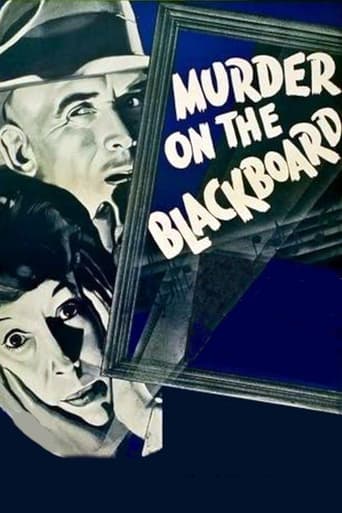utgard14
Second entry in the Hildegarde Withers series sees teacher Withers (Edna May Oliver) discovering the body of a murdered fellow teacher in her school. After the police arrive, led by her beau Inspector Piper (James Gleason), they find the body has disappeared. So they investigate and eventually find the body in a particularly gruesome place for a 1934 movie. Now it's up to Hildegarde to ferret out the murderer.As with the last Withers film, the real treat in watching is not with the mystery itself as much as Oliver's enjoyable performance and her banter with Gleason's Piper. Oliver's actually even funnier in this one than in the first movie. I think this is my favorite of the series. It's got a quick pace and lots of funny lines. The murder mystery part is pretty good too. Love the part where Withers explains the school's fire escape to Piper. Little stuff like that fascinates me when I watch older movies. There's even a diagram with directions!
gridoon2018
"Murder On The Blackboard", the second Hildegarde Withers film is, frankly, a disappointment. There is some amusing banter between Edna May Oliver and James Gleason, a bigger role and a couple of funny bits for Edgar Kennedy, the rather strikingly modern-looking, and modern-acting, Gertrude Michael (who also stole the show in another mystery film made the same year, "Murder At The Vanities") in a supporting role as a suspect....and not much beyond that. The whole mystery never really grabs you, and its solution is pretty ho-hum. Worst of all, the film moves so slowly that it becomes a struggle to keep watching it sometimes (a lot of screen time seems to be consumed by the characters wandering around a dark cellar). Leonard Maltin's 3-star rating is a bit too generous in my opinion, I don't think this film is any better than the Ellery Queen films that he so heavily bashes; I give it ** out of 4.
csteidler
Gossip, intrigue, jealousy—and murder? It's all happening in the dark old elementary school where Hildegarde Withers instructs the children by day and keeps an eye on her colleagues after school. But the murder mystery is secondary in this film; the real fun here is watching Miss Withers and Inspector Oscar Piper team up for another round of professional discourtesy and friendly insults—with, just by the way, a murder investigation thrown in.Hildegarde and Oscar (as they have grown close enough to call each other) are of course played by the great Edna May Oliver and James Gleason. The verbal interaction between the two is delightful (Oscar: "Well, we caught him quicker than I thought." Hildegarde: "Almost anything could be done quicker than you think, Oscar."). The physical interplay between the two is just as much fun to watch—sometimes subtle, sometime broad, consistently mischievous. (The scene where they search classroom closets—Oscar opens a door and peers in, Hildegarde noses and squirms her way in around him, he pretends to shut the door on her—is just hilarious.) The rest of the cast is fine; it's your basic array of suspects, more or less. Edgar Kennedy does lend notable support as an assistant detective. Poor Officer Kennedy—he gets conked on the head early in the picture and winds up in the hospital, then later in the movie is set up as bait! And of course no one listens to his protests….My favorite Gleason line (to Oliver, of course): "Just because you found the body, you think you're Mrs. Sherlock Holmes!" Good fun for fans of great character actors.
tedg
When talkies happened, there was a mad rush to make films of mysteries because they were enormously popular in the pulp trade. Series of published stories became movie serials as if by accident and it took nearly a whole decade for the movie industry to figure out a basic cinematic vocabulary apart from books.So when you see something that worked during that transition, its worth figuring why. Almost always it was not because of anything in the film itself, rather the stage presence and usually humor of one or two characters.This formula started in 1932 as one of the early talkies. It depended on the character of the nosey biddy and whatever humor could be milked from it. A cartoon cop was the foil, and a pretty effective one too.In this, the second, his cartoonishness becomes self-referential. There are at least three major jokes in the thing where he talks about what he would do if he were a movie detective. One time, the schoolmarm treats him like he is irrelevant and he says: "What am I here, the costume designer?"This was the same year that "The Thin Man" hit on a better, more dialog-driven comic formula that would lead to screwball. So this series flagged a bit, dragging on with different twists.Ted's Evaluation -- 2 of 3: Has some interesting elements.


